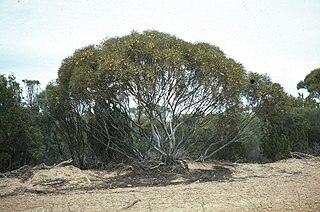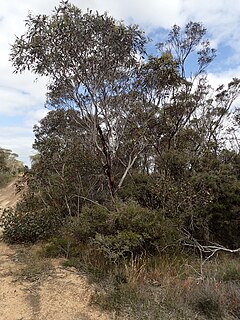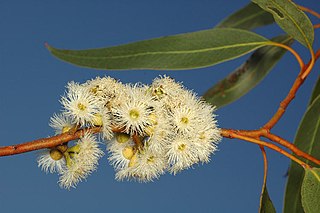Eucalyptus zopherophloia, commonly known as the blackbutt mallee, is a species of spreading mallee that is endemic to an area on the west coast of Western Australia. It has rough bark over part or all of the trunk, smooth grey bark above, narrow lance-shaped leaves, flower buds in groups of nine or eleven, creamy white flowers and conical fruit.

Eucalyptus deflexa, commonly known as Lake King mallee, is a species of mallee that is endemic to Western Australia. It has smooth grey to whitish bark, linear to elliptic or curved adult leaves, pendulous flower buds arranged in groups of seven, cream-coloured or pink flowers and pendulous barrel-shaped fruit.

Eucalyptus flavida, commonly known as yellow-flowered mallee, is a species of mallee that is endemic to Western Australia. It has smooth greyish bark, sometimes with rough, flaking brownish bark at the base, lance-shaped adult leaves, long, elongated, tapering flower buds in groups of nine or eleven, yellow flowers and cylindrical or barrel-shaped fruit.

Eucalyptus hebetifolia is a species of mallee that is endemic to southern Western Australia. It has smooth grey and brownish bark with loose ribbons of bark near the base, lance-shaped adult leaves, flower buds in groups of up to thirteen, creamy white flowers and conical to barrel-shaped fruit.
Eucalyptus incerata, commonly known as Mount Day mallee, is a species of mallee that is endemic to southern Western Australia. It has smooth bark, lance-shaped adult leaves, flower buds with a long, horn-shaped operculum and arranged in groups of seven, yellow flowers and barrel-shaped to cup-shaped fruit.

Eucalyptus johnsoniana, commonly known as Johnson's mallee, is a species of mallee that is endemic to Western Australia. It has smooth, greyish brown bark, sometimes with flaky to fibrous brownish bark at the base, lance-shaped adult leaves, flower buds in groups of seven, creamy white flowers and shortened spherical fruit with an unusually small opening.
Eucalyptus melanophitra is a species of mallet that is endemic to a restricted area of Western Australia. It has rough, flaky grey bark on the trunk, smooth grey bark above, narrow lance-shaped adult leaves, flower buds in groups of nine or eleven, pale yellow flowers and cylindrical to barrel-shaped fruit.
Eucalyptus microschema is a species of small, shrubby mallee that is endemic to the southwest of Western Australia. It has smooth, silvery grey bark, linear adult leaves, flower buds in groups of nine or eleven, white flowers and short, barrel-shaped fruit. It is restricted to a small area near Newdegate.
Eucalyptus obesa, commonly known as the Ninety Mile Tank mallee, is a species of mallee that is endemic to Western Australia. It has smooth, greyish to pale brown bark, usually lance-shaped adult leaves, flower buds in groups of between eleven and fifteen, creamy white flowers and shortened spherical to hemispherical fruit.
Eucalyptus olivina is a species of mallee or a tree that is endemic to Western Australia. It has smooth greyish bark, linear to narrow lance-shaped adult leaves, flower buds in groups of seven or nine, creamy white flowers and short barrel-shaped to cup-shaped fruit.

Eucalyptus petraea, commonly known as granite rock box, is a species of mallee or a small tree that is endemic to Western Australia. It has thin, ribbony or flaky to fibrous bark on the lower trunk, smooth greyish above, lance-shaped adult leaves, flower buds usually in groups of seven, creamy white flowers and conical fruit.
Eucalyptus prominens is a species of mallee that is endemic to a small area on the west coast of Western Australia. It has smooth greyish bark, sometimes with rough bark near the base, lance-shaped adult leaves, flower buds in groups of seven or nine, white flowers and conical fruit.
Eucalyptus quadrans is a species of mallee or a small tree that is endemic to the southwest of Western Australia. It has smooth, greyish bark, narrow lance-shaped adult leaves, flower buds in groups of seven, white flowers and cup-shaped fruit that are square in cross-section.
Eucalyptus rigens, commonly known as saltlake mallee, is a species of sprawling mallee that is endemic to the southwest of Western Australia. It has smooth bark, lance-shaped adult leaves, flower buds in groups of three on a flattened peduncle and sessile, ribbed fruit.

Eucalyptus sporadica, commonly known as the Burngup mallee, is a species of mallee that is endemic to the southwest of Western Australia. It has smooth bark, lance-shaped adult leaves, flower buds in groups of seven, yellowish flowers and down-turned, conical to cylindrical fruit.
Eucalyptus surgens is a species of mallee that is endemic to a small area on the south coast of Western Australia. It has rough bark near the base of the stems, glossy green lance-shaped leaves, flower buds in groups of seven, creamy yellow flowers and cup-shaped to cylindrical fruit.
Eucalyptus thamnoides is a species of mallee that is endemic to south western Western Australia. It has smooth bark, lance-shaped adult leaves, flower buds in groups of seven, cream-coloured to pale yellow flowers and cup-shaped, conical or bell-shaped fruit.

Eucalyptus utilis, commonly known as coastal moort or coastal mort, is a species of mallet or mallee that is native to southern areas of Western Australia. It has smooth bark, egg-shaped to lance-shaped adult leaves, flower buds in group or seven, creamy white flowers and conical fruit.

Eucalyptus chlorophylla, commonly known as green-leaf box, northern glossy-leaved box or glossy-leaved box, is a species of eucalypt that is endemic to northern Australia. It is a tree or mallee, with hard, rough bark, lance-shaped or curved adult leaves, flower buds in groups of seven, creamy white flowers and usually conical fruit.
Eucalyptus cuprea, commonly known as the mallee box, is a species of mallee that is endemic to the west coast of Western Australia. It has rough, flaky bark on the base of its trunk, smooth coppery-coloured bark above, lance-shaped adult leaves, flower buds in groups of seven, creamy white flowers and conical to cup-shaped fruit.











